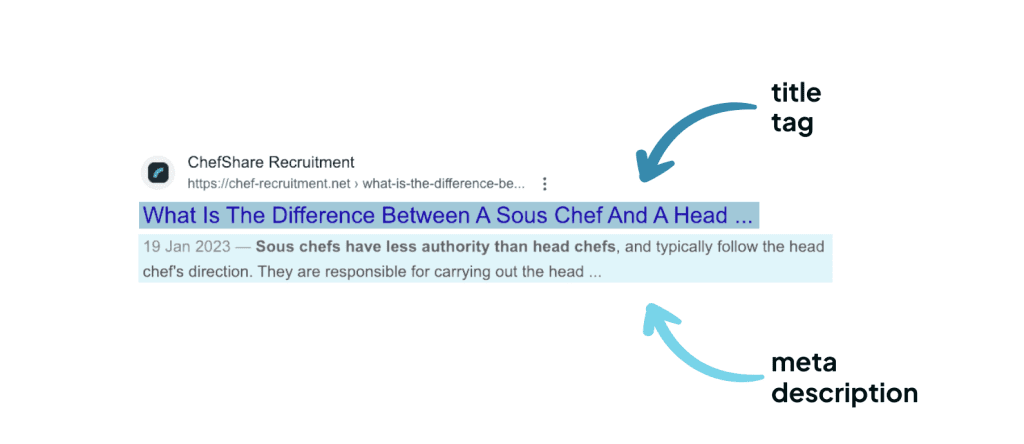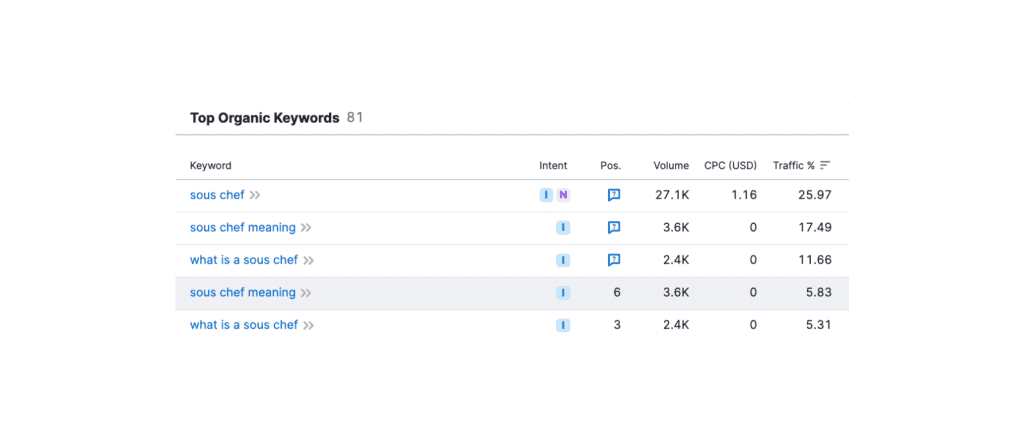If you’re looking to climb the ranks of Google’s search results, then you need to get your blog posts in top shape!
Just like the human body, a blog post has many parts that play crucial roles in serving different functions and determining its overall health and performance. To make sure that your blog post is visible to search engines and attracts a significant amount of organic traffic, you’ll need to pay attention to each of these parts and develop them for search engine optimisation (SEO).
To help explain these different parts, we’ve enlisted the help of Rye, one of our SEO team leads, who with our team of experts at Outrank, has helped countless businesses climb to the top of search engine results pages. One such business, Chefshare, has greatly benefited from the power of efficiently an written blog, ranking first on Google’s PAA for highly competitive terms like ‘sous chef’, drawing them in over 10,000 monthly visitors.
So, scrub in and let’s explore the anatomy of an SEO-friendly blog post!
The Face
Title & Meta Description
Just like a person’s face, the title and meta description are the first thing people see when they search for a topic.

The title should be creative and compelling, while also accurately reflecting the content of the post. The meta description, on the other hand, is a brief summary of what the post is about. It should be concise and informative, giving readers a clear idea of what they can expect from your post. It’s important to optimise both the title and meta description with relevant keywords so that they can be easily found by search engines.
When it comes to making each of these SEO friendly, it’s important to strike a balance between being creative and informative. A title that is too vague or misleading will only lead to a high bounce rate, while a meta description that is too long may not be fully displayed in search results.
Rye’s Top Tip…
Always keep your audience in mind and write for them, not just for search engines. This begins with your title and meta description. If they both provide value to your readers, they’re more likely to click through to your post and spend time on your website, ultimately helping to improve your rankings.
The Heart
Keywords
Keywords are the core of your blog’s relevance and the underlying structure of your post.

They help search engines understand what your post is about and how it relates to the searcher’s query. When choosing keywords, it’s important to focus on those that are relevant to your topic and your target audience. Use long-tail keywords to narrow down your niche and improve your chances of ranking for specific search queries. Make sure to also use variations of your keywords throughout your post to avoid keyword stuffing and to make your content more natural and readable.
In addition to choosing the right keywords, it’s also important to use them strategically throughout your post. Start by using your primary keyword in your title, meta description, and first paragraph. From there, use variations of your keyword in your subheadings and throughout the body of your post.
Rye’s Top Tip…
Don’t overdo it. Aim for a keyword density of around 1-2% to avoid being penalised by search engines. Above all, make sure your content is valuable and engaging for your readers. Keywords are important, but they’re by no means the sole factor that determines your search engine rankings.
The Spine
Content
Just as the backbone is the foundation that supports the rest of the body, the content of a blog post is the foundation of the post that supports other elements such as the title, subheadings, images, and links.

It’s where you can provide value to your readers and position yourself as a thought leader within your niche, by sharing knowledge, insights, and opinions related to a topic around your business. When creating content, it’s important to remain original, informative, and engaging. It helps to use data, statistics, and examples to back up your points and establish credibility. Don’t forget to also include images, videos, and other multimedia to make your post more visually appealing and shareable.
Rye’s Top Tip…
In addition to creating high-quality content, it’s important to also optimise it for search engines. Use descriptive subheadings and bullet points to make your post easy to scan and read. Use internal links to other relevant posts on your website and external links to credible sources to provide additional value to your readers.
Be sure to also optimise your content for mobile devices. In today’s mobile-first world, ensuring that the post is suitable for mobile devices is essential to providing a positive user experience and best ensuring the post’s success.
The Arms
Backlinks & Guest Posts
Backlinking and guest posting are like the arms of your blog post; they help you reach out to a wider audience and increase your domain authority.

Backlinks are links from other websites that point to your site. The more high-quality backlinks you have, the more authoritative your site appears to search engines. There’s several ways to earn backlinks; you could start by creating valuable content that other websites want to link to, or instead, directly reach out to other websites and ask them to link to your content.
Guest posting is another effective way to build backlinks and increase your reach. By guest posting on other websites, you can tap into their audience and gain exposure for your business. When guest posting, it’s important to choose websites that are relevant to your niche and have a high domain authority.
Rye’s Top Tip…
Always provide value to their audience by creating high-quality content that is relevant to their readers. In return, you can include a link back to your own website, which will help boost your search engine rankings.
The Legs
Structure
The structure of your blogs are like the legs of your body; providing stability and support to your content and making it easier to navigate.

When structuring your blog, it’s important to use a clear and organised layout. Use headings and subheadings to break up your content into sections and make it easy to scan. Also consider using short paragraphs and bullet points to make your content more readable and engaging.
In addition to a clear layout, it’s also important to optimise your blog for search engines. Use descriptive URLs, title tags, and meta descriptions to help search engines understand the structure and content of your website.
Rye’s Top Tip…
Use internal links to connect different blog posts and make it easier for readers to navigate your website.
When posting online, having an SEO-friendly blog post can mean the difference between being at the top of the search results or buried deep on page ten.
At Outrank, our speciality is helping businesses outrank their competition on Google. Our team of experts know the ins and outs of SEO and can help support your website with blogs that are optimised for search engines and are engaging for your audience. Whether you need help with keyword research, content creation, or backlinking, we’ll provide you with the strategies and tools you need to succeed.
Contact us today to learn more about how we can help you outrank your competition and take your business to the next level.





